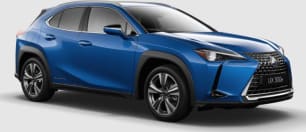I had high expectations for the LBX Morizo RR and I’m pleased to say they were met.
What a phenomenally capable little car.
Lexus is at pains to point out that its mechanical cousins - the Toyota GR Corolla and Yaris - are motorsport bred and therefore more raw and hardcore.
The premium brand knows it needs to be able to attract new buyers with a car like this, while also satisfying its loyal base.
Lexus did this by building a hot hatch (okay, it’s an SUV) that you can easily live with day to day.
I spent an enjoyable few hours behind the wheel of the Morizo RR on a stunning Autumn day in Victoria’s Yarra Ranges driving on some incredible roads. The twists, bends, undulations and more showcased how tight this car is.
First up that engine is an absolute gem, and I don’t miss the extra kilowatts found in the Toyota models. There’s very little turbo lag and the LBX picks up pace quickly but in a focused, fun manner.
The engine note is also a delight to behold, especially when you push it hard. Although on coarse chip roads a fair bit of road noise creeps in, to the point that it's boomy.
The transmission is a perfect pairing for the engine, too, offering slick shifts without holding gears unnecessarily. I didn’t miss the manual box found in the Toyotas, either. But the paddle shifters and a true manual mode (it won’t shift unless you flick the paddle) adds to the experience.
The brakes are strong but not too pinchy and the steering is as sharp as you’d hope, while offering just enough weight.
Then there’s the grip. The all-wheel drive system “automatically distributes the front-rear torque according to road conditions and grip”, according to Toyota.
That AWD grip always inspires confidence during dynamic driving in a car like this and the LBX sticks to the tarmac like nobody's business. Despite some damp sections of road higher up the ranges, no slip was detected. It feels glued to the road.
If that’s not enough, the Lexus surprises with its compliant and even comfortable ride quality. Many hot hatches (or hot SUVs) have a firm ride due to a chassis set-up geared to performance driving.
Somehow Lexus has ensured the damping settings shield the occupants from the worst bumps. Only deep potholes make their presence felt.
And that’s the beauty of this car. It feels so beautifully engineered, with a clear focus on performance, but it’s not a brutal experience. You never feel like you could easily lose control in this thing. You can punt it into a tight bend and feel confident it will stay the course.





